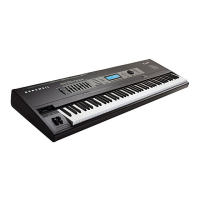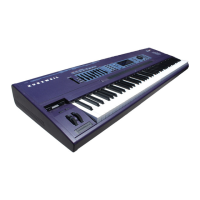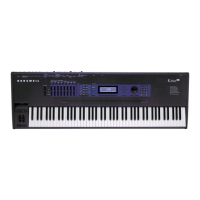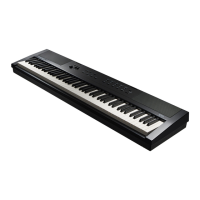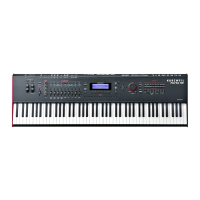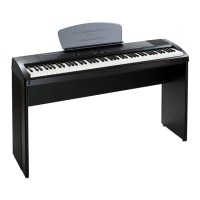19-2
Audio Outputs
Audio Routing: Programs to KDFX
Audio Routing: Programs to KDFX
1. In any mode (typically Program mode), highlight a program name with the cursor, then
press
Edit
to enter the Program Editor. Note how many layers there are in the program.
2. Press one of the
more
soft buttons until you see OUTPUT at the bottom of the display.
Press the corresponding soft button to view the OUTPUT page for the current layer.
3. Set the value of the Pair parameter as desired. This value determines which KDFX input
(AÐD) gets the output from the current program layer.
4. Repeat this process for each layer in the program (or, if youÕre editing a setup, for every
layer of every program in the setup).
Audio Routing: KDFX to Audio Outputs
Every program that uses KDFX has a studio assigned to it. The studio deÞnes the KDFX
parameters for the program to which itÕs assigned.
1. In the Program Editor, press one of the
more
soft buttons until you see KDFX at the
bottom of the display. Press the corresponding soft button to view the KDFX page for the
current layer.
2. Highlight the Studio parameter, then press
Edit
to enter the Studio Editor.
3. Press the
OUTPUT
soft button to view the OUTPUT page for the current studio. Note that
it controls all layers of the program.
4. Set the values for each of the four Output parameters. These parameters represent the four
pairs of analog outputs; the parametersÕ values specify which KDFX output bus gets
routed to each of the analog outputs.
Using the Optional Digital Outputs
Digital audio output is available for K2600s that have either the sampling option or the
digital I/O option. Each option gives you different possibilities for digital output conÞguration.
The sampling option provides 16-bit stereo digital output, via coaxial (XLR) or optical output
jacks that are supplied with the sampling option. The output is routed through the samplerÕs
analog-to-digital converter (ADC). The stereo digital out carries either the K2600Õs analog Mix
output, or an external analog signal converted to digital. You can choose either SPDIF or AES/
EBU format for the output. You can set the output sample rate at 48, 44.1, 32, or 29.6 KHz, or you
can slave the K2600 to an external clock via one of the stereo digital inputs. These inputs also
enable you to sample digital signals, as described on page 14-8.
The digital I/O option provides 16- or 20-bit eight-channel digital output in KurzweilÕs
proprietary KDS format, via a serial port supplied with the digital I/O option. YouÕll need to
connect a Kurzweil DMTi or other KDS-compatible device to the serial port. The digital I/O
option also provides direct stereo digital output (optical or coaxial).
With the digital I/O option, the output sample rate is Þxed at 48 KHz. The digital I/O option
also provides eight channels of KDS-format digital input, which you can route into VAST
programs. See
Playback Mode
on page 6-26.
If your K2600 has both the sampling option and the digital I/O option, you can route the signal
to the stereo digital outputs either through the sampler, or directly.
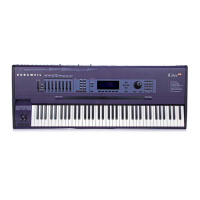
